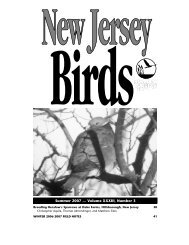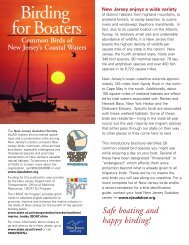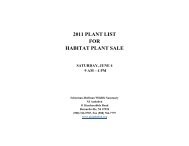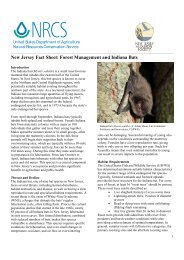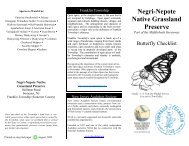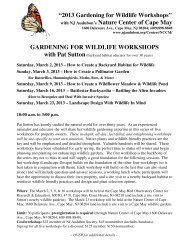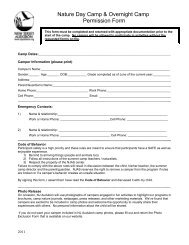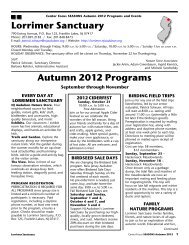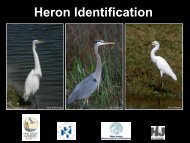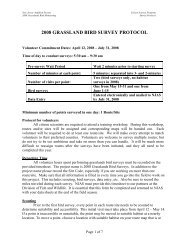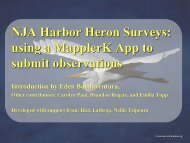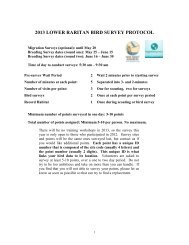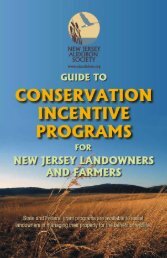March through May, 2009 - New Jersey Audubon Society
March through May, 2009 - New Jersey Audubon Society
March through May, 2009 - New Jersey Audubon Society
You also want an ePaper? Increase the reach of your titles
YUMPU automatically turns print PDFs into web optimized ePapers that Google loves.
Figure 4. Mean peak counts (bars) with 95% confidence intervals (lines) of<br />
shorebirds observed on Delaware Bay beaches in aerial surveys, spring 1986-<br />
2008. Years were separated into groups of 6 years (except 1998-2002, 5<br />
years) to better portray general trends.<br />
over for shorebirds. Peak single day counts averaged<br />
nearly 180,000 shorebirds, with a high of over 426,000<br />
shorebirds counted on one survey in 1986, and a low<br />
of 100,000 in 2003. Although we cannot estimate<br />
how many individual shorebirds these counts represent<br />
without knowing length of stay, these counts are<br />
minimum numbers that place Delaware Bay among<br />
the ten largest staging sites in the Western Hemisphere<br />
(Senner and Howe 1984, WHSRN <strong>2009</strong>). Moreover,<br />
the number of shorebirds using the vast marshes and<br />
mudflats of the bayshore were sampled in transect<br />
surveys conducted in the early 1990s, and were<br />
estimated to be more than double the number of<br />
birds counted on beaches (Clark unpubl. data). However,<br />
the actual number of total migrant shorebirds<br />
using Delaware Bay cannot be estimated without a<br />
better estimate of shorebirds using bay marshes and<br />
nearby Atlantic coastal habitats concurrent with<br />
shoreline surveys. The number of total shorebirds<br />
may be useful in the future as an index of shorebirds<br />
using the Delaware Bay shoreline, particularly in<br />
the context of measurable changes in habitats and<br />
sea level.<br />
Another element of stopover importance is the<br />
portion of a species population in one location at one<br />
time (WHSRN 1990). Our data show that a major<br />
portion of the Red Knot population uses Delaware Bay<br />
during the spring migration. In recent years the Red<br />
Knot population has been the subject of intense study,<br />
resulting in a well-informed estimate of population<br />
size of 18,000 to 33,000 in 2007-2008 (Niles et al.<br />
2008). Thus the Delaware Bay stopover supports the<br />
overwhelming majority of the hemispheric population<br />
of Red Knots each spring.<br />
Delaware Bay also hosts a large portion of the<br />
Ruddy Turnstone population: there is low confidence<br />
in the U.S. population estimate of 180,000 turnstones<br />
(Morrison et al. 2006), but if it correct, then the<br />
average peak count of 55,000 represents 26% of their<br />
population, and high counts of 100,000 (observed in<br />
1989 and 1998) are 47% of their population. Average<br />
and high counts of Sanderlings in Delaware Bay<br />
may represent 4% and 11%, respectively, of the total<br />
U.S.–hemispheric Sanderling population estimated<br />
at 300,000 (Morrison et al. 2006). The population of<br />
Semipalmated Sandpipers is estimated at 2 million,<br />
although there is low confidence in that number.<br />
The number of semipalmateds counted on Delaware<br />
Bay beaches is between 4% and 13% of that figure<br />
(Morrison et al. 2006), although many more were<br />
certainly uncounted in the salt marsh mudflats. Red<br />
Knots, turnstones and Sanderlings were all classified<br />
by Andres et al. (2006) as species of high conservation<br />
concern, mostly due to declining populations as<br />
measured in Delaware Bay and elsewhere.<br />
90 — <strong>March</strong> <strong>through</strong> <strong>May</strong>, <strong>2009</strong>



